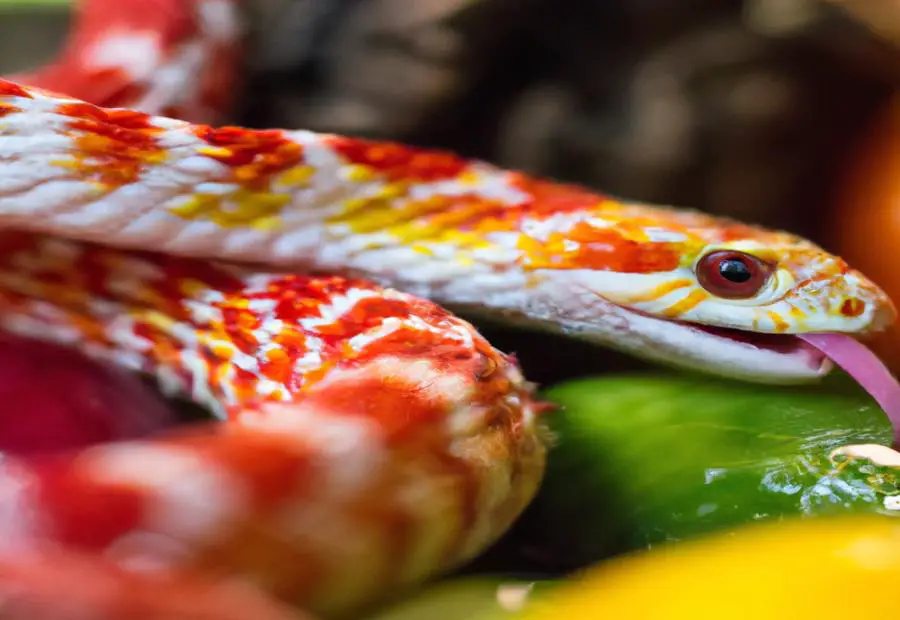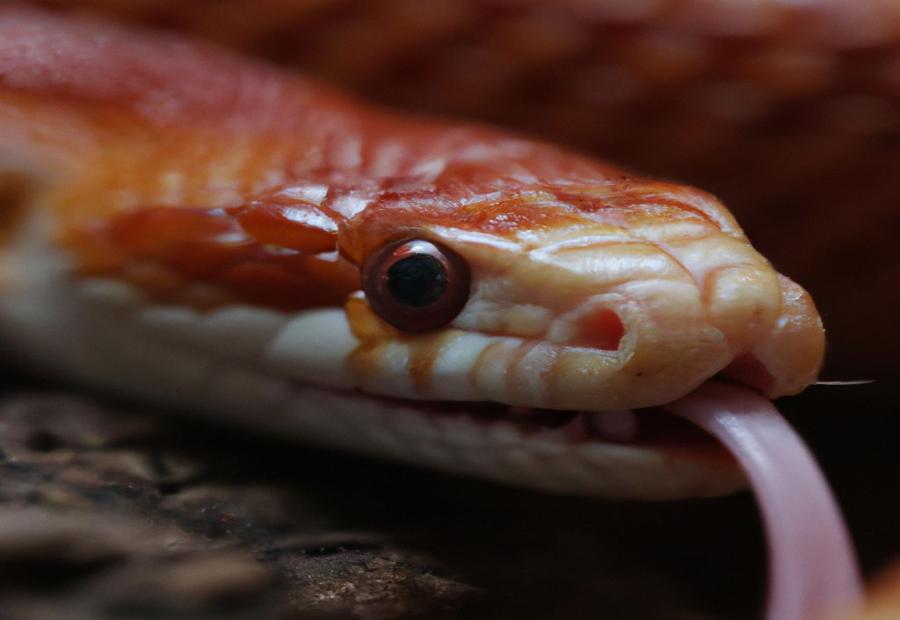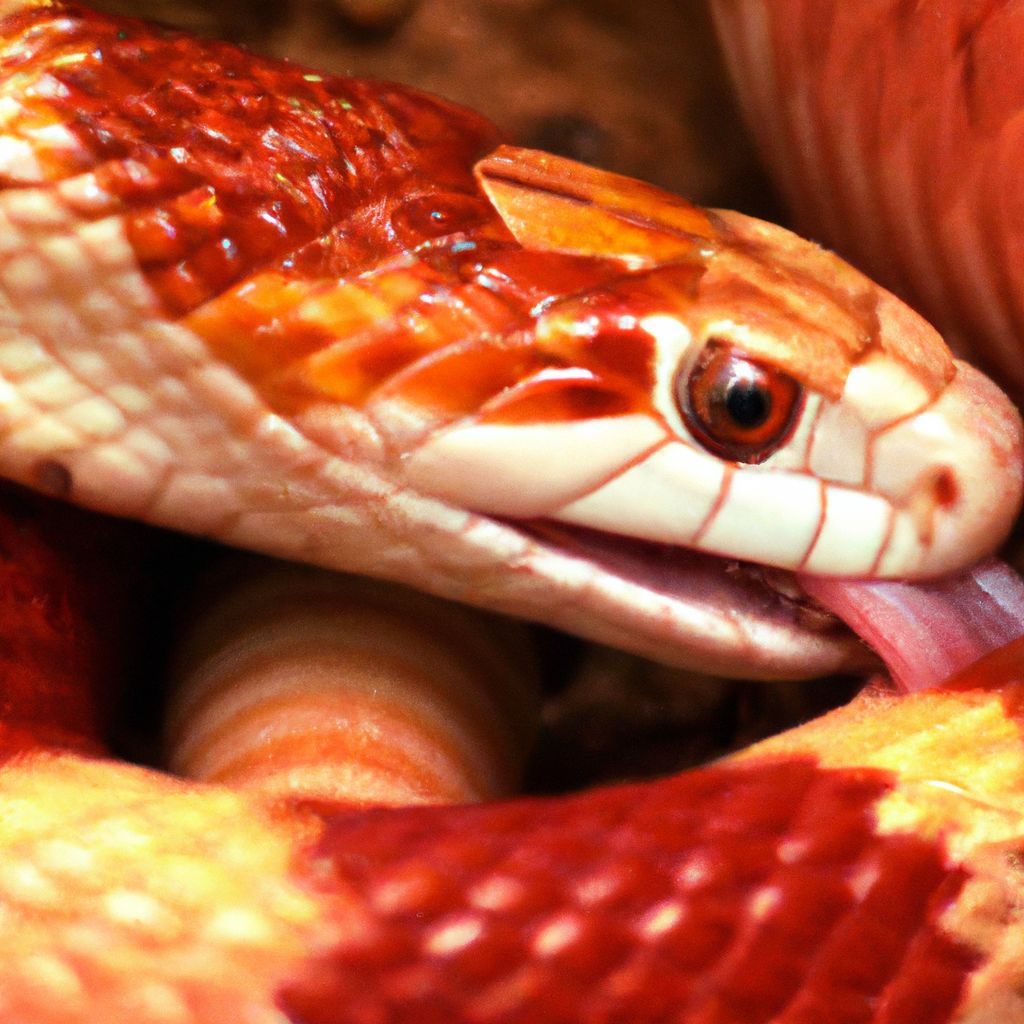Corn snakes are popular pet reptiles known for their attractive patterns and relatively easy care requirements. Understanding their dietary needs is essential to ensure their health and well-being. This article provides a detailed diet list for corn snakes, covering the various prey items they consume.
Corn snakes are carnivorous and primarily feed on small animals. The diet of a corn snake mainly consists of:
- Rodents, including mice and rats
- Birds
- Eggs
- Insects
- Other small prey
When it comes to feeding corn snakes, the frequency and portion size varies depending on their age and size. Juvenile corn snakes require more frequent meals, while adult corn snakes can be fed less often.
Feeding corn snakes involves certain considerations and precautions. These include selecting an appropriate prey size, choosing the right prey type, establishing a feeding schedule, and using proper feeding techniques to ensure the safety and well-being of both the snake and the prey.
By understanding the dietary needs and following the recommended feeding practices, you can ensure that your corn snake remains healthy and thrives in its captive environment.
Key takeaway:
- Corn snakes eat a variety of prey including rodents, birds, eggs, insects, and other small prey.
- The amount and frequency of feeding depends on the age of the corn snake, with juvenile snakes requiring more frequent feedings than adults.
- When feeding corn snakes, it is important to consider the size and type of prey, as well as establish a feeding schedule and use proper feeding techniques.
What Do Corn Snakes Eat?

Photo Credits: Ruggedreptiles.Com by Larry Young
Curious about the culinary preferences of corn snakes? Brace yourself for a tantalizing tour through their appetites! From rodents and birds to eggs, insects, and other small prey, this section unravels the diverse diet of corn snakes. Each sub-section will unveil the intriguing delicacies that these slithering creatures can’t resist. So, get ready to explore the fascinating world of what corn snakes truly enjoy sinking their fangs into!
1. Rodents
Rodents are a crucial food source for corn snakes. They play a vital role in providing the necessary nutrients for the snake’s growth and development.
When it comes to feeding corn snakes, the choice of rodent type is significant. There are different options available, such as juvenile rats, baby pink mice, adult mice, and even jumbo mice. Rats can also be a suitable choice for feeding corn snakes.
The appropriate prey size is an important factor to consider when feeding corn snakes. For juvenile corn snakes, smaller prey items like baby pink mice or juvenile rats are recommended. As corn snakes grow into adulthood, they can handle larger prey items such as adult mice or even larger rodents.
It is crucial to ensure that the prey size is suitable for the snake’s body size. This ensures that it can be easily swallowed without causing any harm. Furthermore, live feeders are essential for corn snakes as they heavily rely on their sense of smell to locate their prey.
To provide a well-balanced and nutritious diet for your corn snake, it is advisable to offer a variety of rodents, including mice and rats. Consulting a feeding chart or reputable rodent distributors can help determine the appropriate prey size and feeding schedule for your corn snake. Providing a balanced diet is essential for both the mental and physical health of the snake.
Always prioritize the well-being of your corn snake by sourcing prey items from reliable and convenient food sources.
2. Birds
Birds are a crucial part of the corn snake’s diet. These snakes primarily consume small birds and also enjoy feeding on quail eggs. The inclusion of birds in their meals provides essential nutrition that promotes the health and development of corn snakes.
To meet the dietary requirements of corn snakes of various ages and sizes, it is important to offer a diverse range of food items. When providing small birds as food for corn snakes, owners should ensure that the birds are of the appropriate size for easy swallowing and digestion.
Additionally, quail eggs serve as a nutritious option that adds variety to the snakes’ diet. By incorporating small birds and quail eggs into their feeding schedule, corn snake owners can ensure their pets receive all the necessary nutrients for their well-being.
It is vital to maintain a balanced feeding schedule and use prey sizes that are suitable for the corn snake’s overall health.
3. Eggs
Corn snakes have a variety of food options, including eggs. Eggs provide essential nutrients for the snake’s growth and development. Below is a table that outlines the different types of eggs that corn snakes can eat:
| Egg Type | Description |
|---|---|
| Quail Eggs | Small and convenient food sources for corn snakes. They can be easily sourced from supermarkets or specialized pet stores. |
| Other Small Bird Eggs | Slightly larger meal options for the snake. They should be obtained from reputable sources to ensure freshness and quality. |
Pro-tip: When feeding eggs to your corn snake, ensure they are the right size and fresh. Avoid using eggs from wild or unknown sources to prevent contamination and potential harm to your snake’s health.
4. Insects
Insects play a significant role in a corn snake’s diet. Butterworms, silkworms, waxworms, crickets, mealworms, roaches, and grasshoppers are suitable options for feeding a corn snake. These insects add variety in terms of textures and flavors, thereby enhancing the snake’s feeding experience. When selecting these insects, it is crucial to ensure they are sourced from reputable distributors who provide safe and healthy prey.
Including insects in a corn snake’s diet is beneficial as it provides both mental and physical enrichment. It allows them to engage in natural hunting behavior, satisfying their instincts and keeping them active. However, it is important to choose the appropriate size of prey based on the snake’s age and size. By offering a variety of insects and other food options, the snake can maintain a balanced diet.
When feeding insects to a corn snake, it is essential to consider the size of the prey to prevent digestion problems. Following a feeding schedule and avoiding overfeeding is also crucial to prevent health issues associated with obesity. By incorporating insects into a corn snake’s diet, owners can ensure a diverse and nutritious feeding routine that promotes the overall well-being of the snake.
5. Other Small Prey
Corn snakes can consume small amphibians like frogs or salamanders. They can also eat green anoles, which are small lizards. Additionally, corn snakes have been known to eat button quails, which are small birds.
It’s important to ensure that the prey size is appropriate for the snake’s body size. Maintaining your snake’s mental and physical health involves providing a varied diet. Source these small prey items from reliable rodent distributors or pet stores to ensure quality and safety.
Remember, a diverse diet enhances the well-being and proficiency of your corn snake.
How Much and How Often Should Corn Snakes Be Fed?
Feeding your pet corn snake is crucial for its health and wellbeing. In this section, we’ll dive into the question of how much and how often you should feed your corn snake. We’ll explore the differences between feeding juvenile corn snakes and adult corn snakes, ensuring you have a clear understanding of their specific dietary needs. So, let’s get ready to uncover the secrets of providing optimal nourishment for your slithery friend!
1. Juvenile Corn Snakes
When feeding juvenile corn snakes, it is important to provide them with a varied and appropriate diet in order to support their growth and development. Suitable food options for these young snakes include baby pink mice, small rodents such as rats or juvenile mice, as well as occasional amphibians like frogs or toads. Additionally, small birds like pinky chicks and quail eggs can also be included in their diet. It is important to ensure that the prey being offered is not wider than the widest part of the snake’s body to avoid any feeding difficulties. As the snake grows, it is recommended to gradually increase the size of the prey. To promote the mental and physical health of the juvenile corn snakes, it is advisable to feed them live feeders, as this allows them to utilize their natural hunting instincts.
2. Adult Corn Snakes
Adult Corn Snakes have specific dietary needs for optimal health. Here is a table summarizing their food items:
| Juvenile Rats | Small Rodents | Adult and Jumbo Mice | Occasional Amphibian | Small Birds | Quail Eggs | Green Anoles (lizards) | Button Quail |
Adult corn snakes primarily eat juvenile rats, small rodents, adult and jumbo mice, occasional amphibians, small birds and their eggs, small lizards like green anoles, and button quail.
Consider the prey size when feeding adult corn snakes. The prey should be appropriate for the snake’s body size to ensure easy consumption and digestion. A varied diet of these food items promotes mental and physical health.
As a corn snake owner, provide fresh and appropriately sized live feeders. Source food from reputable rodent distributors for quality and safety. Providing a balanced and varied diet based on their needs enhances well-being and vitality.
Feeding Tips and Precautions for Corn Snakes

Photo Credits: Ruggedreptiles.Com by Keith Wright
Feeding our corn snakes can be a fascinating and rewarding experience, but it’s important to do it right. In this section, we’ll explore some valuable feeding tips and precautions to ensure the health and well-being of our slithery friends. From choosing the right prey size and type to establishing a proper feeding schedule and mastering the best feeding techniques, we’ll cover it all. So, let’s dive in and become experts in nourishing our corn snakes!
1. Prey Size
”
The prey size for corn snakes varies based on age and size. Juvenile corn snakes eat smaller prey like juvenile rats, baby pink mice, and occasionally, an amphibian. Adult corn snakes eat larger prey such as adult and jumbo mice, small birds, quail eggs, and prey that matches their body size.
”
”
Pro-tip: Make sure the prey size is appropriate for your corn snake’s size to avoid health issues or difficulties in swallowing. Regularly assess your corn snake’s size and adjust the prey size to maintain their mental and physical health.
”
2. Prey Type
Prey Type
Corn snakes primarily consume rodents, birds, eggs, insects, and other small prey. The table below lists the different types of prey that corn snakes eat:
– Rodents: Mice (juvenile and adult), Rats (juvenile and adult)- Birds: Small birds- Eggs: Quail eggs- Insects- Other Small Prey: Occasional amphibian, green anoles
It is important to note that the prey size should be appropriate for the snake’s age and body size. Younger corn snakes, such as baby corn snakes, require smaller prey items like baby pink mice, while adult corn snakes can consume larger prey like adult and jumbo mice. Snakes have a keen sense of smell, which helps them locate their food.
Corn snake owners can obtain prey items from reputable rodent distributors or breed their own live feeders. It is essential to ensure that the prey is fresh and suitable for the snake’s mental and physical health. By considering the prey type and providing a varied diet, corn snake owners can meet their pets’ nutritional needs and promote their overall well-being.
3. Feeding Schedule
Feeding Schedule
When it comes to the feeding schedule for corn snakes, it is important to establish a routine that ensures optimal health and well-being. It is recommended for juvenile corn snakes to be fed every 5 to 7 days for rapid growth and development. On the other hand, adult corn snakes should be fed every 10 to 14 days as their metabolic rate slows down with maturity. It is important to note that the size of the prey should match the snake’s body width. For feeding, it is best to use live feeders as corn snakes prefer to hunt and catch prey, which also provides mental and physical stimulation. Always monitor the feeding process to ensure the snake’s safety and never leave the snake unattended. A pro-tip to enhance the feeding experience is to vary the type of prey, including rodents, occasional amphibians, and small birds, to provide nutritional variety and mimic the snake’s natural diet in the wild.
4. Feeding Techniques
Feeding Techniques
When feeding corn snakes, it is important to follow these feeding techniques:
1. Prepare the food: Make sure to have the appropriate prey size ready. For young snakes, baby pink mice are recommended, while larger adults can be given adult or jumbo mice.
2. Utilize the snake’s sense of smell: Allow the snake to use its sense of smell by presenting the prey item in front of it.
3. Offer live feeders: Corn snakes have a preference for live prey, so it is recommended to use live mice or rats from reputable rodent distributors.
4. Monitor the snake’s feeding behavior: Observe if the snake shows interest and strikes the prey. This indicates that it is ready to be fed. If not, it is advisable to try again later.
5. Provide a suitable feeding environment: To prevent substrate ingestion, either put the snake in a separate enclosure or use a feeding container.
6. Feed at appropriate intervals: Follow a feeding schedule that takes into consideration the snake’s age and size. Young snakes may require more frequent feeding compared to adults.
By adhering to these feeding techniques, you can ensure the mental and physical well-being of your corn snake while providing the necessary nourishment.
Some Facts About What Do Corn Snakes Eat? A Detailed Diet List:
- ✅ Corn snakes primarily eat small mammals like mice, rats, and squirrels. (Source: terrariumquest.com)
- ✅ In captivity, most corn snakes are fed commercially reared, frozen-thawed rodents as their main food source. (Source: terrariumquest.com)
- ✅ Hatchling and juvenile corn snakes consume lizards and frogs as their primary prey. (Source: terrariumquest.com)
- ✅ Commercially reared, frozen-thawed mice are the most common food for pet corn snakes. (Source: a-z-animals.com)
- ✅ Corn snakes have a keen sense of smell and use constriction to capture and kill their prey. (Source: a-z-animals.com)
Frequently Asked Questions
What do corn snakes eat?
Corn snakes are carnivorous and primarily eat small mammals like mice, rats, and squirrels. They may also consume other prey items such as birds, frogs, and lizards.
How frequently should I feed my corn snake?
The frequency of feeding varies depending on the snake’s age and size. Hatchling corn snakes should be fed every 5-7 days, juveniles every 7 days, and adults every 10-14 days.
What size prey should I offer my corn snake?
The prey should be about 1-1.5 times the width of the snake’s body at mid-length. The size of the prey should create a modest bulge in the snake’s body.
Can I feed live prey to my corn snake?
It is recommended to use frozen/thawed prey rather than live feeders to avoid any risk of injury to the snake. However, if the snake refuses to eat frozen/thawed prey, live feeders can be offered under supervision.
Do corn snakes require any supplements in their diet?
Commercially-bred feeder rodents may be deficient in certain nutrients, so vitamin supplements may be necessary to ensure a balanced diet for your corn snake. It is best to consult with a reptile veterinarian for specific recommendations.
Can corn snakes eat anything besides rodents?
While rodents are the mainstay of a corn snake’s diet, other prey options such as button quail, quail eggs, green anoles, house geckos, and Reptilinks can be added to their diet for variety and additional nutritional benefits.


